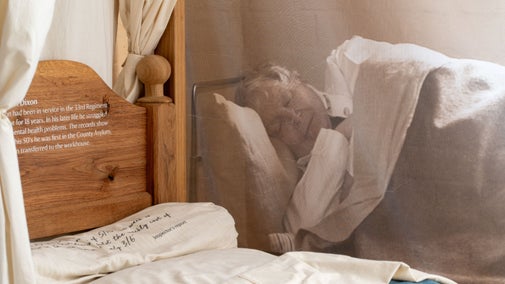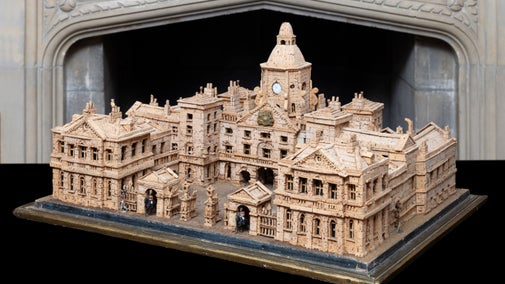
The Workhouse and Infirmary's collection
Explore the objects and works of art we care for at The Workhouse and Infirmary on the National Trust Collections website.

Not many people realise that The Workhouse has a collection of over 1,000 objects, many of which are too fragile to regularly be displayed to visitors. From coils of oakum to lost shoes, even everyday items have a story to tell and memories to spark. Discover what’s in the collection and the highlights voted for by visitors.
On the 20th anniversary of The Workhouse and Infirmary being acquired by the National Trust, we marked the milestone through a display of objects co-curated with visitors.
Among the artefacts in the collection is a child's shoe, most likely worn by a boy or girl living in the bedsit accommodation within the former Workhouse building.
According to visitors, the shoe evoked memories of their own childhoods, as well as provoking thoughts about what might have happened to the shoe's wearer.
- Visitor to the '20 objects' exhibition
Children lived at this workhouse site for over 150 years and records show that in March 1847 there were 74 children here. They received an education and training so that they could begin work or an apprenticeship at around 12 years of age.
Even after this building was no longer in use as a workhouse, the local council used the former women's dormitories to temporarily house homeless women and children into the late 1970s.
- Visitor to the '20 objects' exhibition

Workhouse records are often scarce, with so many having been destroyed or lost over time. Our collection includes a register listing births and deaths for the period 1914 to 1940, when The Workhouse had become known as Greet House.
Once one of the many records kept by the Master, it now provides a rare glimpse of the individuals who stayed here.
The register was discovered in the upstairs ceiling during restoration work. It has been repaired and conserved following a kind donation by the North Nottinghamshire National Trust Association.
- Shelley, Adminstrator at The Workhouse

Although the diets of The Workhouse inmates were originally designed in keeping with the concept that life inside should not be better than life outside, the food received was often better than those living in poverty would have eaten daily.
This mug may well have held a pauper's tea allowance. While it was not permitted for everyone, inmates over 60 years of age received 1oz. of tea per week according to the 1835 Poor Law Commission.

Explore the objects and works of art we care for at The Workhouse and Infirmary on the National Trust Collections website.
Learn about the concept and the history of The Workhouse and Infirmary and the role that they played.

Find out more about visiting The Workhouse and Infirmary, where guided tours, exhibitions and activities help bring to life the stories of the people who had to work to receive food, shelter and medical care here.

From plot to pauper plate, explore the recreated Victorian vegetable garden and admire the range of heritage varieties grown.

Learn how a project to restore the Infirmary unfolded, the stories being told and how it’s helping to shape conversation about care, 150 years after it first opened.
Discover how we care for The Workhouse and the items in its collection, including original Victorian wallpaper from the Infirmary.

The art and heritage collections we care for rival the world’s greatest museums. Learn more about the collection of paintings, decorative art, costume, books, household and other objects at historic places.

See the breadth of our collection of works of art, furniture and more: we care for around a million objects at over 200 historic places, there’s a surprise discovery around every corner.

Discover the stories behind some of the greatest artworks and artefacts looked after by the National Trust, as told in a dedicated book, 125 Treasures from the Collections of the National Trust.
